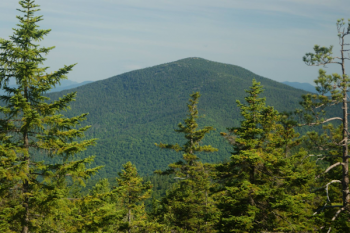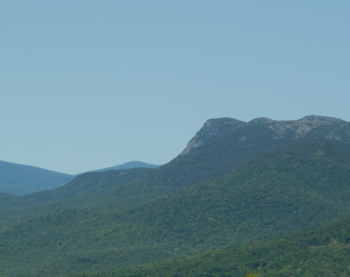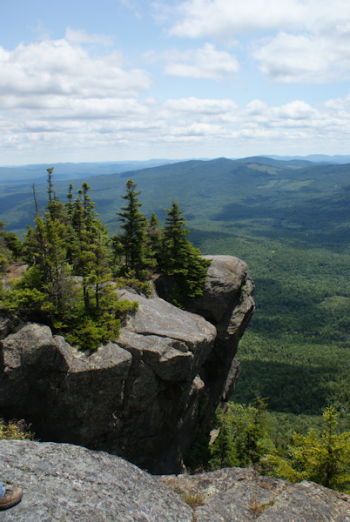Ask Professor Puzzler
Do you have a question you would like to ask Professor Puzzler? Click here to ask your question!

6th grader Vanshika from Kolkata asks the following question: "Why are mountains in a triangular shape???"
Hi Vanshika, strictly speaking, mountains aren't triangular shaped, since a triangle is a two dimensional shape, and mountains are three dimensional. I suppose we could talk about cones, instead of triangles, as in this picture, which is a mountain I've hiked several times, named Kearsarge North (Intervale, New Hampshire).
Most mountains, though, are not quite so nicely conical; here's a picture of another one of my favorite mountains - Bigelow Mountain in Stratton, Maine. This mountain has five or six peaks stretched out across a ridge that takes a couple days to cross.

And yet...one day I was approaching this mountain from a different angle, and didn't recognize it, because it looked like one giant triangle. I was looking at the end of the mountain, so all I saw was a single peak, which was very clearly triangular!
So instead of saying that mountains are cones (which they aren't, for the most part) maybe we could say their cross sections are often triangular. Do you know what a cross section is? A cross section is the open face you would get if you took a knife and sliced it in a perfectly straight line through the mountain. For example, if you cut an orange in half, the cross section would be a circle. If you cut a box in half, the cross section would be a rectangle. So maybe we could say that if you cut a mountain perpendicular to its ridge-line, you would most likely get something that is approximately a triangle shape. Even that isn't going to be 100% true, but it's a pretty good "rule of thumb" for most of the mountains I've hiked. The key idea is that they are wider at the base than at the top, like a triangle.
But your question remains: Why are mountains shaped this way?
Let me try to put this in a simple way. My son (who is not quite four years old) likes to play in the sand. One of the things he enjoys doing in the sand is "building towers." His idea of building a tower is to pour sand in one place. The sand turns into a small pile, and that pile gets larger the more sand he puts on it. It doesn't take long before the sand that he's pouring on starts sliding down the sides of the pile, making the pile not just taller, but also wider at the base. He's forming a cone.
Why does this happen? Well, there are two forces acting on the particles of sand. One of them is the force of gravity pulling the sand toward the ground. The other is the force of friction. Friction is what keeps two objects from sliding past each other. Imagine sliding two pieces of paper against each other, then imagine sliding two pieces of sandpaper against each other. Sliding the sandpaper will be harder to do, because of the roughness of the two pieces of paper. We say that there is more friction between them.
These two forces are competing against each other. The force of gravity is pulling the sand down, while the force of friction is holding it in place. The amount of gravitational force which causes motion varies depending on the slope (or angle) of the surface on which the particle of sand is resting. Thus, if the pile is steep, gravity outweighs friction, but if the angle is shallow, friction wins. Therefore, as my son pours that sand, once it has piled up to the point that gravity outweighs friction, the sand starts sliding down the side, until the base has spread out enough that the slope is shallow again, and friction outweighs gravity once more.
Can you visualize that?
Hopefully, after that explanation, you're thinking to yourself, "Yeah, but the mountains weren't formed by pouring sand out of the sky!"
Right you are! Mountains are formed by different processes than pouring sand. In fact, if you've ever been on a mountain, you know that in many cases, they are made of mostly rock, not sand. Mountains are formed by tectonic forces, earthquakes, and even volcanic eruptions. While these forces are in play, the same principles of friction and gravity still hold true, resulting in the familiar triangle shape.
And once a mountain is formed, it is subject to forces of erosion - rain washing the soil away, landslides, crumbling rocks, etc. And these forces function in similar ways to what was described above. The steeper a mountain is, the more heavily it is affected by erosion, leading, over time, to a generally triangular shape.

Of course, it's possible for a mountain to be very lopsided; we haven't said that the triangular shape will be symmetrical. Here's a picture I took when I went hiking with my little boy yesterday.
This mountain is called Tumbledown Mountain. Would you like to know why? Because it is believed that, long long ago, the side of this mountain tumbled down. One entire face of the mountain simply collapsed, leaving a very steep (cliff-like) slope. Why did this happen? Perhaps the granite weakened at the bottom through ice-wedging and other erosional forces, and when the weakened granite collapsed, everything above it collapsed as well.
Well..almost everything above it collapsed. Here's a picture taken from the top of that cliff.

Notice how that rock ledge hangs out over empty space? Once upon a time it wasn't like that; there was solid rock below it. Now all that rock is in a heap at the bottom of the mountain, while this one remaining piece of rock hangs out precariously 2000 feet above ground!
Aren't mountains great?


